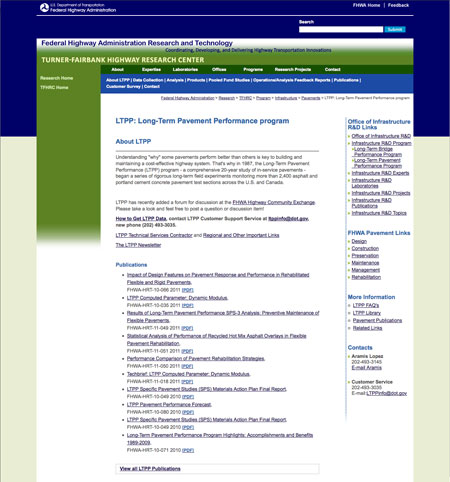U.S. Department of Transportation
Federal Highway Administration
1200 New Jersey Avenue, SE
Washington, DC 20590
202-366-4000
Focus
| Accelerating Infrastructure Innovations |
Publication Number: FHWA-HRT-12-008
Date: November 2011
Printable Version (.pdf, 0.6 mb)
Three new Tech Briefs available from the Federal Highway Administration's (FHWA) Long Term Pavement Performance (LTPP) program present highlights from a recently released LTPP report on Impact of Design Features on Pavement Response and Performance in Rehabilitated Flexible and Rigid Pavements (Pub. No. FHWA-HRT-10-066).
Performance Comparison of Pavement Rehabilitation Strategies (Pub. No. FHWA-HRT-11-050) looks at rehabilitation strategies for both flexible and rigid pavements. The impact of overlay thickness, preparation prior to constructing an overlay, and mix type on performance are evaluated using data from the LTPP Specific Pavement Study (SPS)-5 and SPS-6 experiments. The 32 experiment sites included 18 rehabilitation projects that used asphalt concrete, 8 projects that featured asphalt concrete overlays over jointed plain concrete pavements, and 6 projects that used jointed reinforced concrete pavements. Sites were monitored for periods ranging from 8 to 17 years.
The performance evaluation included looking at outcomes for pavement smoothness and fatigue cracking and then developing a practical ranking of rehabilitation strategies from best to worst. Results, for example, indicated that thick overlays best improved the performance of rehabilitated asphalt concrete pavements with regard to smoothness and fatigue cracking. Results also showed that using virgin hot-mix asphalt (HMA) versus reclaimed asphalt pavement (RAP) did not have a significant effect on performance.
Statistical Analysis of Performance of Recycled Hot Mix Asphalt Overlays in Flexible Pavement Rehabilitation (Pub. No. FHWA-HRT-11-051) compares the performance of RAP to virgin mixes in asphalt overlays constructed as part of the SPS-5 experiment. Performance was evaluated by examining load-associated distress, including roughness, rutting, and fatigue cracking. As the Tech Brief notes, "the performance data from LTPP SPS-5 shows that RAP and virgin HMA mixes used in overlays of flexible pavements showed approximately the same performance across a range of climates, traffic, and existing pavement conditions over a period of up to 17 years."
An overview of the LTPP program's SPS-3 experiment is found in Results of Long-Term Pavement Performance SPS-3 Analysis: Preventive Maintenance of Flexible Pavements (Pub. No. FHWA-HRT-11-049). The SPS-3 experiment evaluated four preventive maintenance alternatives: thin HMA overlays, slurry seals, crack seals, and chip seals. These treatments focus on improving the pavement's functional performance and prolonging pavement life, rather than improving structural capacity.
Each SPS-3 site was also categorized according to five design factors:
Thirty-three States and Canadian Provinces participated in the experiment, which included 81 sites. Performance was evaluated according to the deterioration measured by fatigue cracking, rutting, and roughness (using the International Roughness Index). Overall results indicated that chip seals and thin overlays had the highest levels of performance. All treatments were effective to some degree relative to the performance of the experiment's control section.
To download copies of the Tech Briefs or the full report, visit www.fhwa.dot.gov/research/publications/technical/infrastructure/pavements/ltpp. For more information on the LTPP SPS experiments, contact Larry Wiser at FHWA, 202-493-3079 (email: larry.wiser@dot.gov). To learn more about the LTPP program, visit www.fhwa.dot.gov/pavement/ltpp.

For more information about the LTPP program, visit www.fhwa.dot.gov/pavement/ltpp.

LTPP pavement rehabilitation experiments included jointed concrete pavements.


The LTPP program's SPS-5 and SPS-6 experiments examined rehabilitation strategies for both flexible and rigid pavements.